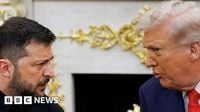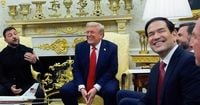On August 18, 2025, the White House became the stage for a high-stakes diplomatic gathering that could shape the fate of Ukraine and the balance of power in Europe for years to come. US President Donald Trump, Ukrainian President Volodymyr Zelenskyy, and a formidable lineup of European leaders—including German Chancellor Friedrich Merz, Italian Prime Minister Giorgia Meloni, British Prime Minister Keir Starmer, French President Emmanuel Macron, Finnish President Alexander Stubb, European Commission President Ursula von der Leyen, and NATO Secretary General Mark Rutte—sat down in Washington, D.C. to chart a path forward in the face of Russia’s ongoing war against Ukraine. The meeting came just days after Trump’s headline-grabbing summit with Russian President Vladimir Putin in Anchorage, Alaska, a session that left many observers anxious about the future of transatlantic unity and Ukraine’s sovereignty.
The stakes could hardly have been higher. According to OSV News, the White House meeting was quickly scheduled in the wake of the Alaska summit, which marked the first face-to-face between a US president and Putin since Russia’s full-scale invasion of Ukraine in 2022. The urgency was palpable. European leaders, rattled by the optics and outcomes of Trump’s meeting with Putin, rushed to Washington to ensure that Ukraine’s interests—and Europe’s own security—would not be sidelined in a potential US-Russia deal.
Friday’s Alaska summit, as reported by BBC, was long on ceremony but short on diplomatic breakthroughs. Trump and Putin delivered statements that shed little light on substantive progress, and neither leader took questions from the press. The lack of a clear ceasefire agreement, which Trump had previously touted as a minimum requirement for negotiations, left European allies and Ukraine’s supporters uneasy. Metropolitan Archbishop Borys A. Gudziak of the Ukrainian Catholic Archeparchy of Philadelphia voiced concern to OSV News that the summit failed to address the “fundamental moral and geopolitical questions” of Russia’s invasion.
As the dust settled from Alaska, European leaders mobilized with remarkable speed. Their goal was twofold: to reinforce transatlantic unity in support of Ukraine and to press Trump for concrete commitments on security guarantees. The optics, as described by the Atlantic Council, were striking—Zelenskyy flanked by a veritable A-list of European power brokers, all presenting a united front to the American president. This show of unity was no accident; it was a carefully orchestrated effort to strengthen Zelenskyy’s hand and to remind Trump that Europe remains Ukraine’s largest source of support, both politically and economically.
The White House meeting focused on two top priorities: the urgent need for a ceasefire and the architecture of security guarantees for Ukraine. European leaders came prepared, floating the idea of a European-funded $100 billion package of US defensive weapons for Ukraine—an offer designed to incentivize robust US engagement in any future peace framework. While Trump appeared open to the concept of US security guarantees, he was quick to clarify that such assurances might involve “air support” rather than American soldiers on the ground. “I think that the European nations are going to take a lot of the burden. We’re going to help them, and we’re going to make it very secure,” Trump said, according to OSV News.
Yet, the devil is in the details. Trump’s position on territorial concessions remained ambiguous. European leaders were determined to avoid any scenario in which Ukraine would be pressured to cede land to Russia. Despite their efforts, Trump suggested that “possible exchanges of territory” could be discussed, referencing the current line of contact between Russian and Ukrainian forces. This suggestion sparked concern among both European and Ukrainian officials, who fear that any legitimization of Russian-occupied territory could set a dangerous precedent.
Meanwhile, the war’s brutality continued unabated. On the very morning of the White House meeting, Russian forces struck the Ukrainian cities of Kharkiv and Zaporizhzhia, killing 14 people and injuring dozens more. Zelenskyy condemned the attacks as “demonstrative and cynical,” emphasizing that Russia was “deliberately killing people, particularly children,” even as peace talks were underway. The youngest victim, a girl just a year and a half old, was killed in a drone strike on Kharkiv. “They are aware that a meeting is taking place today in Washington that will address the end of the war,” Zelenskyy wrote on social media, as reported by OSV News.
Despite the somber backdrop, the mood inside the White House was markedly more cooperative than during Zelenskyy’s acrimonious visit in February. As BBC noted, the change in tone was itself a small victory for diplomacy. Trump seemed to relish his role as host, and European leaders—mindful of his mercurial tendencies—lavished him with praise in hopes of keeping him engaged. “I think in the past two weeks we’ve probably had more progress in ending this war than we have in the past three and a half years,” Finnish President Alexander Stubb remarked, according to BBC.
Still, major obstacles remain. Trump’s political base remains deeply skeptical of new foreign obligations, and any permanent American commitments to Ukraine could prove politically perilous. The president himself has a track record of abrupt policy shifts, raising questions about the durability of any deal brokered under his watch. As BBC pointed out, “A peace that depends on American assurances may not be a firm foundation on which to build.”
Looking ahead, Trump announced that “arrangements” were being made for a bilateral summit between Putin and Zelenskyy, with a possible three-way meeting to follow. European leaders insisted that a ceasefire must precede any such talks, but Trump indicated that this was unlikely to happen soon. The uncertainty surrounding the next steps only adds to the sense of urgency among Ukraine’s allies.
In the search for a lasting peace, European leaders are exploring the formation of a “Coalition of the Willing” to provide security guarantees for Ukraine. This could involve positioning European troops in unoccupied Ukrainian territory, supported by US intelligence sharing and logistical support—but notably, without American boots on the ground. The details of such an arrangement remain to be hammered out in the coming weeks, with further bilateral and trilateral talks on the horizon.
Some observers, like Notre Dame law professor Mary Ellen O’Connell, argue that a truly just and lawful peace would require Russia’s complete withdrawal from Ukrainian territory and the involvement of the Organization for Security and Cooperation in Europe (OSCE) in organizing peacekeeping efforts. O’Connell praised Trump’s new sanctions on India, which has continued to buy Russian oil during the conflict, as a potential lever to pressure Putin into meaningful negotiations—a tool previous US presidents failed to employ, she told OSV News.
As negotiations continue, one thing is clear: the path to peace in Ukraine is fraught with complexity, competing interests, and no shortage of hard choices. The coming weeks will test the resolve of all parties involved—and the world will be watching closely to see whether the fragile unity displayed in Washington can be sustained long enough to bring about an end to Europe’s bloodiest conflict in a generation.


